technical data Seat Alhambra 2011 Owners Manual
[x] Cancel search | Manufacturer: SEAT, Model Year: 2011, Model line: Alhambra, Model: Seat Alhambra 2011Pages: 385, PDF Size: 7.92 MB
Page 183 of 385
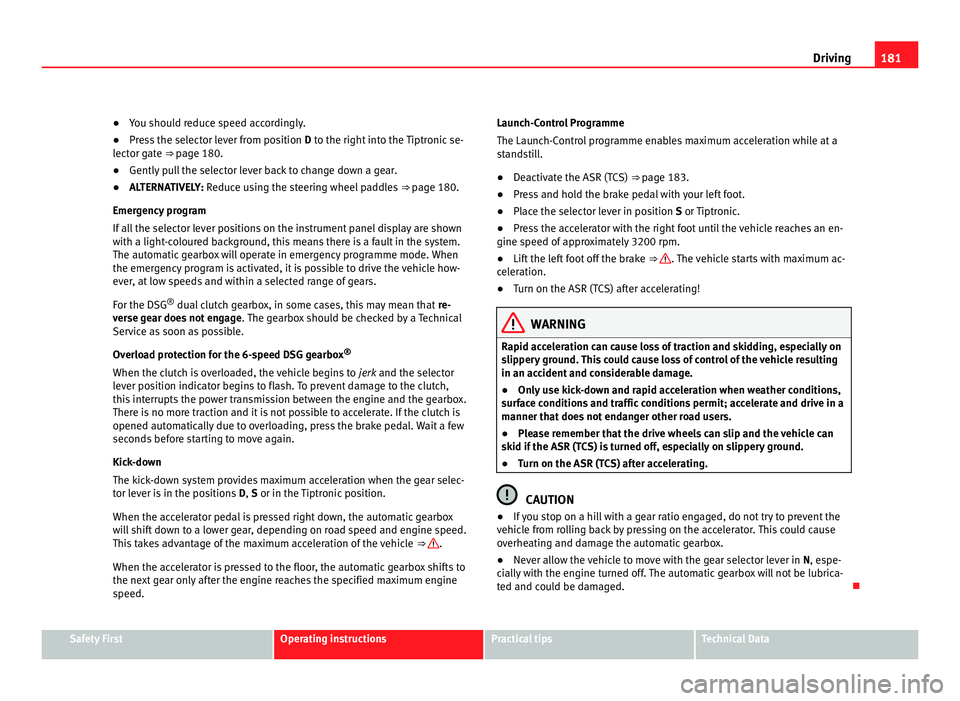
181
Driving
● You should reduce speed accordingly.
● Pre
ss the selector lever from position D to the right int
o the Tiptronic se-
lector gate ⇒ page 180.
● Gently pull the selector lever back to change down a gear.
● ALTERNATIVELY: Reduce u
sing the steering wheel paddles ⇒ page 180.
Emergency program
If all the selector lever positions on the instrument panel display are shown
with a light-coloured background, this means there is a fault in the system.
The automatic gearbox will operate in emergency programme mode. When
the emergency program is activated, it is possible to drive the vehicle how-
ever, at low speeds and within a selected range of gears.
For the DSG ®
dual clutch gearbox, in some cases, this may mean that re-
verse gear does not engage . The gearbox should be checked by a Technical
Service as soon as possible.
Overload protection for the 6-speed DSG gearbox ®
When the clutch is overloaded, the vehicle begins to jerk and the selector
lever position indicator begins to flash. To prevent damage to the clutch,
this interrupts the power transmission between the engine and the gearbox.
There is no more traction and it is not possible to accelerate. If the clutch is
opened automatically due to overloading, press the brake pedal. Wait a few
seconds before starting to move again.
Kick-down
The kick-down system provides maximum acceleration when the gear selec-
tor lever is in the positions D, S or in the Tiptronic position.
When the accelerator pedal is pressed right down, the automatic gearbox
will shift down to a lower gear, depending on road speed and engine speed.
This takes advantage of the maximum acceleration of the vehicle ⇒ .
When the acc el
erator is pressed to the floor, the automatic gearbox shifts to
the next gear only after the engine reaches the specified maximum engine
speed. Launch-Control Programme
The Launch-C
ontrol programme enables maximum acceleration while at a
standstill.
● Deactivate the ASR (TCS) ⇒ page 183.
● Pr
ess and hold the brake pedal with your left foot.
● Place the selector lever in position S or Tiptronic
.
● Press the accelerator with the right foot until the vehicle reaches an en-
gine speed of ap
proximately 3200 rpm.
● Lift the left foot off the brake ⇒ . The vehicle starts with maximum ac-
cel er
ation.
● Turn on the ASR (TCS) after accelerating! WARNING
Rapid acceleration can cause loss of traction and skidding, especially on
slip per
y ground. This could cause loss of control of the vehicle resulting
in an accident and considerable damage.
● Only use kick-down and rapid acceleration when weather conditions,
surf
ace conditions and traffic conditions permit; accelerate and drive in a
manner that does not endanger other road users.
● Please remember that the drive wheels can slip and the vehicle can
skid if the ASR (T
CS) is turned off, especially on slippery ground.
● Turn on the ASR (TCS) after accelerating. CAUTION
● If you stop on a hill with a gear ratio engaged, do not try to prevent the
v ehic
le from rolling back by pressing on the accelerator. This could cause
overheating and damage the automatic gearbox.
● Never allow the vehicle to move with the gear selector lever in N, espe-
c
ially with the engine turned off. The automatic gearbox will not be lubrica-
ted and could be damaged. Safety First Operating instructions Practical tips Technical Data
Page 185 of 385
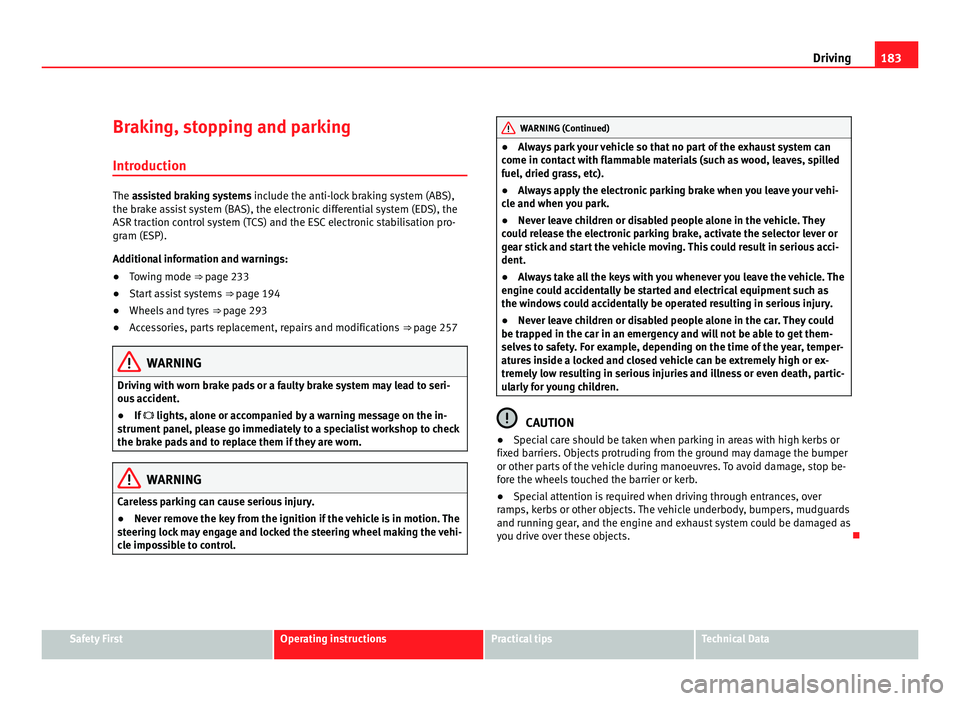
183
Driving
Braking, stopping and parking
Introduction The assisted braking systems include the anti-lock braking system (ABS),
the br
ak
e assist system (BAS), the electronic differential system (EDS), the
ASR traction control system (TCS) and the ESC electronic stabilisation pro-
gram (ESP).
Additional information and warnings:
● Towing mode ⇒ page 233
● St
art assist systems ⇒ page 194
● Wheel
s and tyres ⇒ page 293
● A
ccessories, parts replacement, repairs and modifications ⇒ page 257WARNING
Driving with worn brake pads or a faulty brake system may lead to seri-
ous ac
cident.
● If lights, alone or accompanied by a warning message on the in-
strument
panel, please go immediately to a specialist workshop to check
the brake pads and to replace them if they are worn. WARNING
Careless parking can cause serious injury.
● Never remove the key from the ignition if the vehicle is in motion. The
st eerin
g lock may engage and locked the steering wheel making the vehi-
cle impossible to control. WARNING (Continued)
● Always park your vehicle so that no part of the exhaust system can
c ome in c
ontact with flammable materials (such as wood, leaves, spilled
fuel, dried grass, etc).
● Always apply the electronic parking brake when you leave your vehi-
cle and when
you park.
● Never leave children or disabled people alone in the vehicle. They
coul
d release the electronic parking brake, activate the selector lever or
gear stick and start the vehicle moving. This could result in serious acci-
dent.
● Always take all the keys with you whenever you leave the vehicle. The
engine cou
ld accidentally be started and electrical equipment such as
the windows could accidentally be operated resulting in serious injury.
● Never leave children or disabled people alone in the car. They could
be trapped in the c
ar in an emergency and will not be able to get them-
selves to safety. For example, depending on the time of the year, temper-
atures inside a locked and closed vehicle can be extremely high or ex-
tremely low resulting in serious injuries and illness or even death, partic-
ularly for young children. CAUTION
● Special care should be taken when parking in areas with high kerbs or
fi x
ed barriers. Objects protruding from the ground may damage the bumper
or other parts of the vehicle during manoeuvres. To avoid damage, stop be-
fore the wheels touched the barrier or kerb.
● Special attention is required when driving through entrances, over
ramps, k
erbs or other objects. The vehicle underbody, bumpers, mudguards
and running gear, and the engine and exhaust system could be damaged as
you drive over these objects. Safety First Operating instructions Practical tips Technical Data
Page 187 of 385
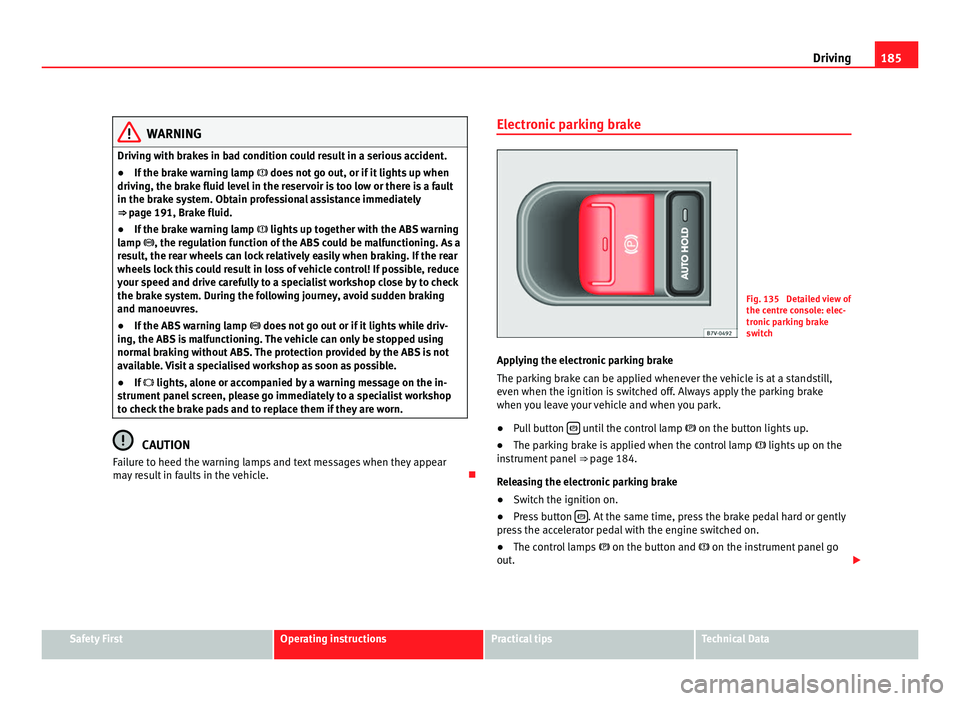
185
Driving WARNING
Driving with brakes in bad condition could result in a serious accident.
● If the brake warning lamp does not go out, or if it lights up when
driving, the brake fluid level in the reservoir is too low or there is a fault
in the brake system. Obtain professional assistance immediately
⇒ page 191, Brake fluid.
● If the brake warning lamp lights up t
ogether with the ABS warning
lamp , the regulation function of the ABS could be malfunctioning. As a
result, the rear wheels can lock relatively easily when braking. If the rear
wheels lock this could result in loss of vehicle control! If possible, reduce
your speed and drive carefully to a specialist workshop close by to check
the brake system. During the following journey, avoid sudden braking
and manoeuvres.
● If the ABS warning lamp does not
go out or if it lights while driv-
ing, the ABS is malfunctioning. The vehicle can only be stopped using
normal braking without ABS. The protection provided by the ABS is not
available. Visit a specialised workshop as soon as possible.
● If lights, alone or accompanied by a warning message on the in-
strument
panel screen, please go immediately to a specialist workshop
to check the brake pads and to replace them if they are worn. CAUTION
Failure to heed the warning lamps and text messages when they appear
ma y
result in faults in the vehicle. Electronic parking brake Fig. 135 Detailed view of
the centr
e c
onsole: elec-
tronic parking brake
switch
Applying the electronic parking brake
The parkin
g brake can be applied whenever the vehicle is at a standstill,
even when the ignition is switched off. Always apply the parking brake
when you leave your vehicle and when you park.
● Pull button until the control lamp
on the button lights
up.
● The parking brake is applied when the control lamp lights up on the
ins
trument panel ⇒ page 184.
Releasing the electronic parking brake
● Switch the ignition on.
● Press button . At the same time, press the brake pedal hard or gently
pre s
s the accelerator pedal with the engine switched on.
● The control lamps on the button and
on the instrument panel go
out. Safety First Operating instructions Practical tips Technical Data
Page 189 of 385

187
Driving
● On slopes, turn the front wheels so that they are against the edge of the
k erb
.
● Uphill, turn the wheels towards the centre of the road. WARNING
The components of the exhaust system reach very high temperatures.
This c
ould cause a fire and considerable damage.
● Always park your vehicle so that no part of the exhaust system can
come in cont
act with flammable materials (such as wood, leaves, spilled
fuel, dried grass, etc). CAUTION
● Special care should be taken when parking in areas with high kerbs or
fi x
ed barriers. Objects protruding from the ground may damage the bumper
or other parts of the vehicle during manoeuvres. To avoid damage, stop be-
fore the wheels touched the barrier or kerb.
● Special attention is required when driving through entrances, over
ramps, k
erbs or other objects. The vehicle underbody, bumpers, mudguards
and running gear, and the engine and exhaust system could be damaged as
you drive over these objects.
Information about the brakes For the first 200 to 300 km (100 to 200 miles),
new brake p
ads have not yet
reached their maximum braking capacity, and need to be “run in” first ⇒ .
The slightly r
educed braking effect can be compensated for by increasing
pressure on the brake pedal. While running in, the full braking distance or
emergency braking distance is larger then when the brake pads have been
run in. While running in, avoid full power braking or situations requiring
braking performance. For example, in heavy traffic. The rate of wear of the brake pads
depends
to a great extent on the condi-
tions in which the vehicle is used and the way the vehicle is driven. If the
vehicle is used frequently in city traffic or for short trips or driven sport style,
visit a specialist workshop regularly more frequently than advised in the
Maintenance Programme to have the bake pads checked.
If you drive with wet brakes, for example, after crossing areas of water, in
heavy rainfall or even after washing the car, the effect of the brakes is less-
ened as the brake discs are wet or even frozen (in winter). At higher speed,
dry the brakes as quickly as possible by braking gently several times. Only
do this without endangering vehicles behind you or any other road users
⇒ .
A la y
er of salt on the discs and brake pads will reduce brake efficiency and
increase braking distance. If you drive for a prolonged period on salted
roads without braking then brake carefully several times to eliminate the
layer of salt on the brakes ⇒ .
If the v
ehicle remains parked for considerable lengths of time, is used little,
or if the brakes are not used, there may be corrosion on the brake discs and
a buildup of dirt on the brake pads. If the brakes are not used frequently, or
if rust has formed on the discs, SEAT recommends cleaning the pads and
discs by braking firmly a few times at a moderately high speed. Only do this
without endangering vehicles behind you or any other road users ⇒ .
Fau lt
s in the brake system
During braking, if you notice that the vehicle does not react as usual (that
the braking distance has increased suddenly) it may be possible that there
is a fault in the braking system. The warning lamp lights up and a text
message displayed. Take the vehicle to a Technical Service immediately and
have the fault repaired. Drive at a moderate speed and be prepared to use
more pressure on the brake pedal, and allow for longer stopping distances.
Brake servo
The brake servo only operates when the engine is running and the pressure
applied by the driver on the brake pedal increases. Safety First Operating instructions Practical tips Technical Data
Page 191 of 385
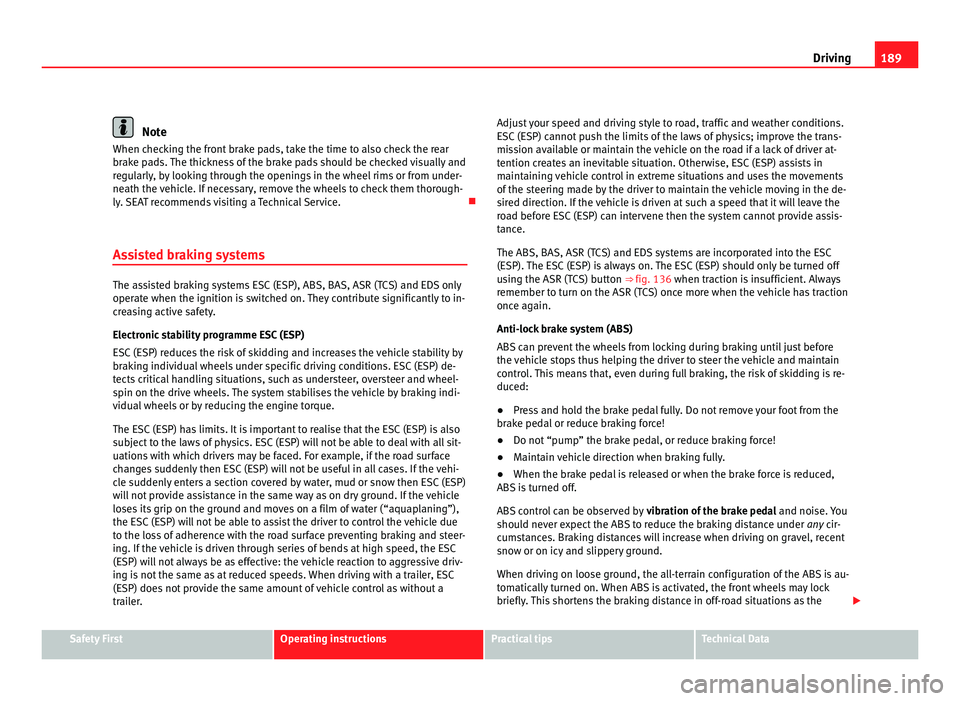
189
Driving Note
When checking the front brake pads, take the time to also check the rear
brak e p
ads. The thickness of the brake pads should be checked visually and
regularly, by looking through the openings in the wheel rims or from under-
neath the vehicle. If necessary, remove the wheels to check them thorough-
ly. SEAT recommends visiting a Technical Service.
Assisted braking systems The assisted braking systems ESC (ESP), ABS, BAS, ASR (TCS) and EDS only
operat
e when the ignition i
s switched on. They contribute significantly to in-
creasing active safety.
Electronic stability programme ESC (ESP)
ESC (ESP) reduces the risk of skidding and increases the vehicle stability by
braking individual wheels under specific driving conditions. ESC (ESP) de-
tects critical handling situations, such as understeer, oversteer and wheel-
spin on the drive wheels. The system stabilises the vehicle by braking indi-
vidual wheels or by reducing the engine torque.
The ESC (ESP) has limits. It is important to realise that the ESC (ESP) is also
subject to the laws of physics. ESC (ESP) will not be able to deal with all sit-
uations with which drivers may be faced. For example, if the road surface
changes suddenly then ESC (ESP) will not be useful in all cases. If the vehi-
cle suddenly enters a section covered by water, mud or snow then ESC (ESP)
will not provide assistance in the same way as on dry ground. If the vehicle
loses its grip on the ground and moves on a film of water (“aquaplaning”),
the ESC (ESP) will not be able to assist the driver to control the vehicle due
to the loss of adherence with the road surface preventing braking and steer-
ing. If the vehicle is driven through series of bends at high speed, the ESC
(ESP) will not always be as effective: the vehicle reaction to aggressive driv-
ing is not the same as at reduced speeds. When driving with a trailer, ESC
(ESP) does not provide the same amount of vehicle control as without a
trailer. Adjust your speed and driving style to road, traffic and weather conditions.
ESC (E
SP) cannot push the limits of the laws of physics; improve the trans-
mission available or maintain the vehicle on the road if a lack of driver at-
tention creates an inevitable situation. Otherwise, ESC (ESP) assists in
maintaining vehicle control in extreme situations and uses the movements
of the steering made by the driver to maintain the vehicle moving in the de-
sired direction. If the vehicle is driven at such a speed that it will leave the
road before ESC (ESP) can intervene then the system cannot provide assis-
tance.
The ABS, BAS, ASR (TCS) and EDS systems are incorporated into the ESC
(ESP). The ESC (ESP) is always on. The ESC (ESP) should only be turned off
using the ASR (TCS) button ⇒ fig. 136 when traction is insufficient. Always remember to turn on the ASR (TCS) once more when the vehicle has traction
once again.
Anti-lock brake system (ABS)
ABS can prevent the wheels from locking during braking until just before
the vehicle stops thus helping the driver to steer the vehicle and maintain
control. This means that, even during full braking, the risk of skidding is re-
duced:
● Press and hold the brake pedal fully. Do not remove your foot from the
brake ped
al or reduce braking force!
● Do not “pump” the brake pedal, or reduce braking force!
● Maintain vehicle direction when braking fully.
● When the brake pedal is released or when the brake force is reduced,
ABS is
turned off.
ABS control can be observed by vibration of the brake pedal and noise. You
should never expect the ABS to reduce the braking distance under any cir-
cumstances. Braking distances will increase when driving on gravel, recent
snow or on icy and slippery ground.
When driving on loose ground, the all-terrain configuration of the ABS is au-
tomatically turned on. When ABS is activated, the front wheels may lock
briefly. This shortens the braking distance in off-road situations as the Safety First Operating instructions Practical tips Technical Data
Page 193 of 385

191
Driving WARNING (Continued)
● Changes to the vehicle suspension or using unapproved wheel/tyre
c omb
inations can affect operation of the ABS, BAS, ASL EDL and ESC
(ESP) and their effectiveness.
● Likewise, the effectiveness of ESC (ESP) depends on the use of suita-
ble ty
res ⇒ page 293. Note
● To ensure that the ESC (ESP) and ASR (TCS) work properly, all four
wheel s
must be fitted with identical tyres. Any differences in the rolling radi-
us of the tyres can cause the system to reduce engine power when this is
not desired.
● If a malfunction should occur in the ABS, the ESC (ESP), ASR (TCS) and
EDS w
ill also be affected.
● Noises may be heard while any of the above systems are operating.
Turning on and off the ASR (TCS) Fig. 136 Detailed view of
the centr
e c
onsole: but-
ton used to switch ASR
(TCS) on and off (vehicles
with ESC (ESP)). The electronic stabilisation control ESC (ESP) consists of ABS, EDL and ASR
(TCS) and on
ly works when the engine is running.
The ASR (TCS) can be switched off while the engine is running by pressing
the OFF ⇒ fig. 136 butt
on.
The ASR (TCS) (and similar) is only switched off
when the required traction is not obtained:
● When driving through deep snow or on loose ground (gravel...).
● When freeing a trapped vehicle.
Turn the ASR (TC
S) back on by pressing the button OFF ⇒ fig. 136.
Brake fluid Fig. 137 In the engine
comp
ar
tment: brake fluid
reservoir, lid
In the course of time, the brake fluid absorbs water from the ambient air. If
there is
too much water contained in the brake fluid, the brake system could
be damaged. In addition, the boiling point of the brake fluid is significantly
lowered. When the brake fluid contains too much water and the brakes are
subject to considerable forces, bubbles of water vapour can form in the sys-
tem. These bubbles of water vapour can significantly reduce braking power, Safety First Operating instructions Practical tips Technical Data
Page 195 of 385
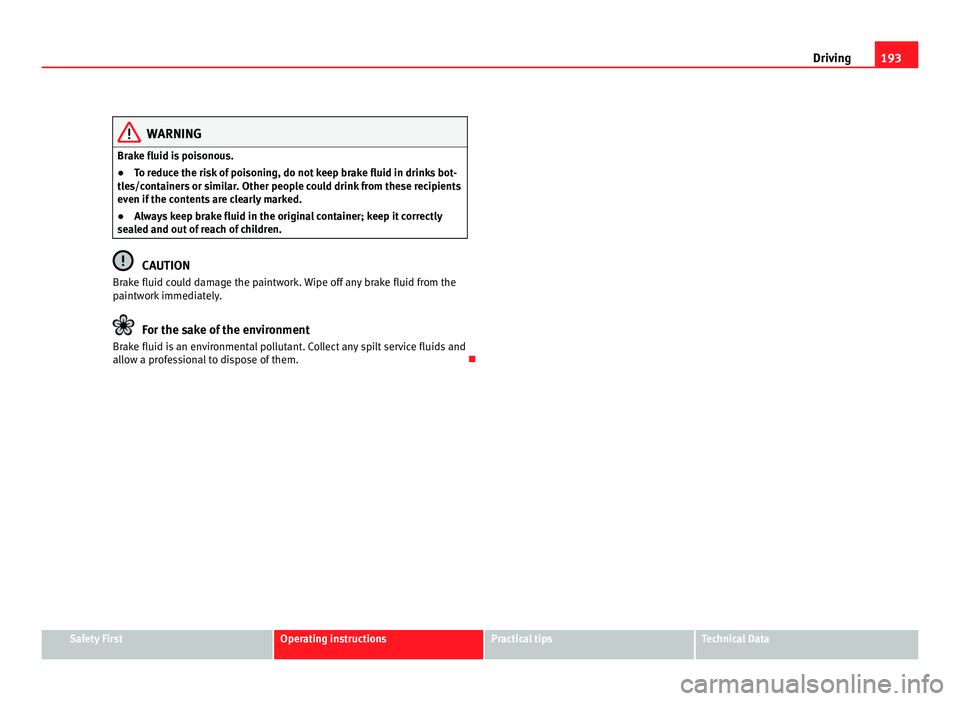
193
Driving WARNING
Brake fluid is poisonous.
● To reduce the risk of poisoning, do not keep brake fluid in drinks bot-
tle s/c
ontainers or similar. Other people could drink from these recipients
even if the contents are clearly marked.
● Always keep brake fluid in the original container; keep it correctly
seal
ed and out of reach of children. CAUTION
Brake fluid could damage the paintwork. Wipe off any brake fluid from the
paintw ork
immediately. For the sake of the environment
Brake fluid is an environmental pollutant. Collect any spilt service fluids and
allo w a pr
ofessional to dispose of them. Safety First Operating instructions Practical tips Technical Data
Page 197 of 385

195
Driving
If any of the conditions necessary for the Auto Hold function change while
the v ehic
le stopped, the system is turned off as is the indicator on the but-
ton ⇒ fig. 138. The electronic parking brake engages where necessary to
park the vehicle safely ⇒ .
Condition s
for keeping the vehicle at a standstill with Auto Hold:
● The driver's door must be closed.
● The driver's seat belt must be buckled.
● The engine must be running.
● The ASR (TCS) system must be switched on ⇒ page 183.
Sw
itching Auto Hold on and off manually
Press the AUTO HOLD button ⇒ . The control lamp on the button switches
off when the Aut o Ho
ld function is switched off.
Permanent Auto Hold connection
The Auto Hold function must be switched on every time the engine is star-
ted. However, to switch the Auto Hold function on permanently, the mark
must be switched on in the Settings menu, “Autohold” submenu
⇒ page 62.
Auto Hold works automatically under the following conditions: All points must be fulfilled simultaneously ⇒ :
manual gearbox Automatic gearbox
1. If the vehicle is
stop
ped using the brake pedal on a flat or slope.2. The engine must be running smoothly.
3. On a slope, the 1st gear is engag-
ed uphil
l
or the reverse gear is en-
gaged for a downhill. The clutch
must be held down. A gear for driving is selected from
R, D or S.
Upon accelerating and pressing in
the clut
c
h simultaneously, the
brake releases gradually. Upon accelerating, the brake re-
le
a
ses gradually. Auto Hold turns off automatically under the following conditions:
manual gearbox Automatic gearbox
1. If one of the conditions mentioned in table on page 195 changes.
2. If the engine is not running regularly or if there is a malfunction.
3. When changing to idle speed. If the selector lever is placed in
neutral
(N
). 4. If the engine is turned off or stalls. If the engine is switched off.
5. If the driver accelerates while
pre
s
sing the clutch in. If the vehicle is accelerated.
6. When one of the wheels has mini-
mal
c
ontact with the ground (for
example, on uneven ground). WARNING
The Auto Hold technology is limited by the laws of physics. The improved
comf or
t provided by Auto Hold should never prompt you to take risks.
● Never leave the vehicle running and with the Auto Hold function
switc
hed on.
● Auto Hold cannot always stop the vehicle uphill and downhill (for ex-
ample, if
the ground is slippery or frozen). CAUTION
Before entering an automatic car wash, alwa
ys switch the Auto Hold func-
tion off, as it could be damaged when the electronic parking brake automat-
ically engages. Safety First Operating instructions Practical tips Technical Data
Page 199 of 385

197
Driving
● If the driver unbuckles his/her seat belt.
● If the driv
er's door is opened.
● If the bonnet is opened.
● In vehicles with a manual gearbox: If a gear has been selected.
Switc
hing Start-Stop mode on and off manually
● Press the button on the centre console ⇒
fig. 139.
● The b
utton will light up when the Start-Stop function is switched off.
The engine wi
ll start immediately if the vehicle is in Stop mode when it is
switched off manually. WARNING
The brake servo and the power steering do not work when the engine is
swit c
hed off.
● Never allow the vehicle to move when the engine is switched off. CAUTION
Using the Start-Stop function for a long period at very high outdoor temper-
atur e
s could damage the vehicle's battery. Note
In some cases, you may have to restart the vehicle using the key. Observe
the corr e
sponding message on the instrument panel display. Safety First Operating instructions Practical tips Technical Data
Page 201 of 385
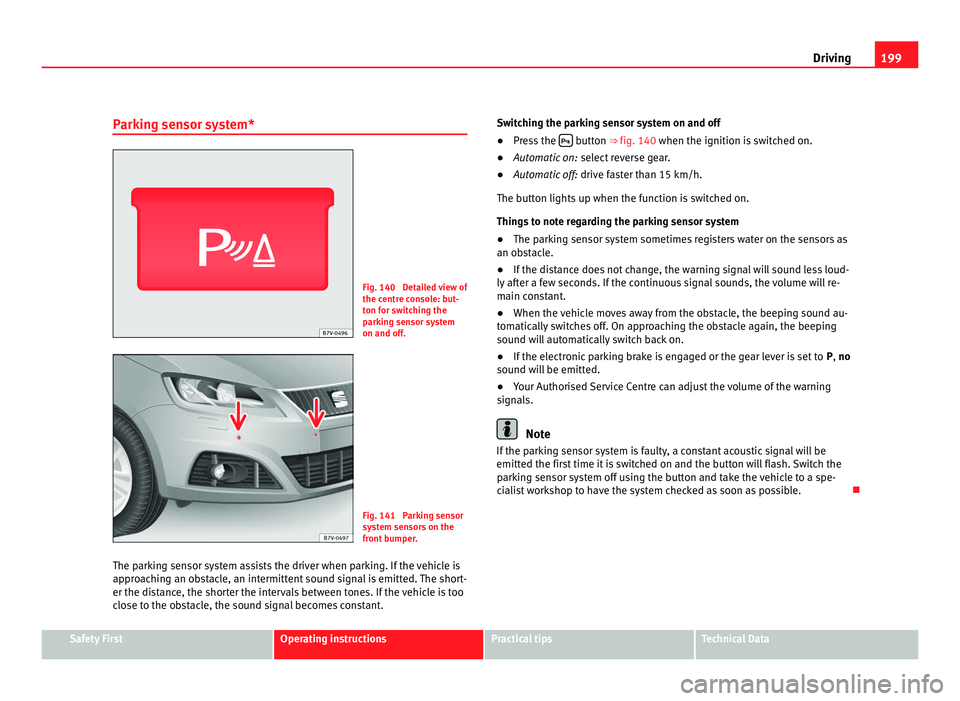
199
Driving
Parking sensor system* Fig. 140 Detailed view of
the centr
e c
onsole: but-
ton for switching the
parking sensor system
on and off. Fig. 141 Parking sensor
sys
t
em sensors on the
front bumper.
The parking sensor system assists the driver when parking. If the vehicle is
appro
aching an obstacle, an intermittent sound signal is emitted. The short-
er the distance, the shorter the intervals between tones. If the vehicle is too
close to the obstacle, the sound signal becomes constant. Switching the parking sensor system on and off
●
Press the button ⇒
fig. 140 when the ignition i
s switched on.
● Automatic on: select r
everse gear.
● Automatic off: drive fa
ster than 15 km/h.
The button lights up when the function is switched on.
Things to note regarding the parking sensor system
● The parking sensor system sometimes registers water on the sensors as
an obs
tacle.
● If the distance does not change, the warning signal will sound less loud-
ly aft
er a few seconds. If the continuous signal sounds, the volume will re-
main constant.
● When the vehicle moves away from the obstacle, the beeping sound au-
tomatic
ally switches off. On approaching the obstacle again, the beeping
sound will automatically switch back on.
● If the electronic parking brake is engaged or the gear lever is set to P, no
sound wi
ll be emitted.
● Your Authorised Service Centre can adjust the volume of the warning
signal
s. Note
If the parking sensor system is faulty, a constant acoustic signal will be
emitted the fir s
t time it is switched on and the button will flash. Switch the
parking sensor system off using the button and take the vehicle to a spe-
cialist workshop to have the system checked as soon as possible. Safety First Operating instructions Practical tips Technical Data